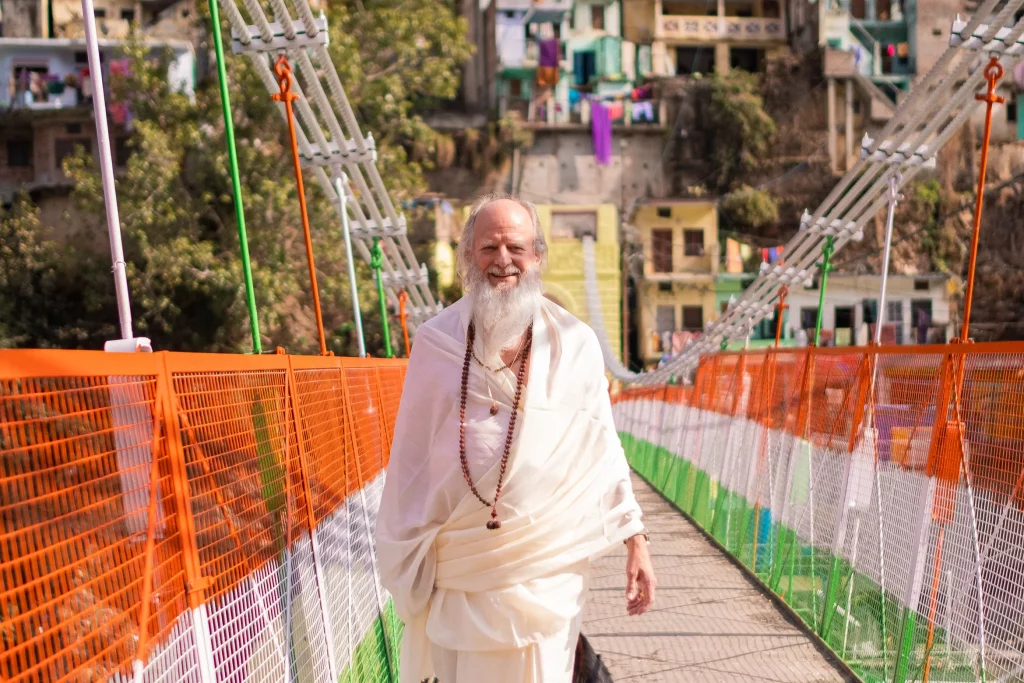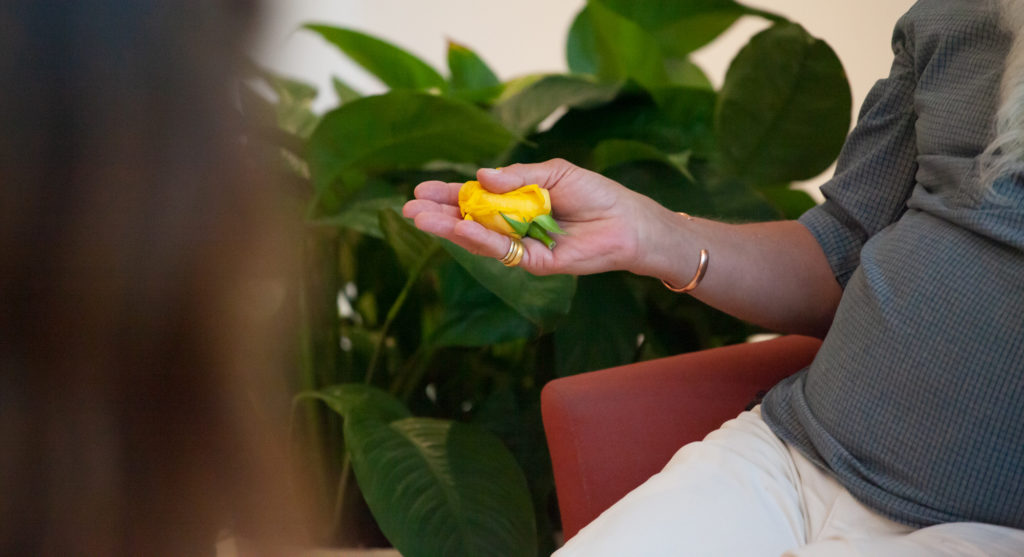In our productivity-oriented culture, we tend to think we’ll find happiness once we achieve our goals. Even if it isn’t the main drive we think about each day, an underlying belief that achievement and fulfillment permeate our culture. Our meditation process shows us that every small step can bring real joy. When you work on your meditation practice, you learn to enjoy little wins that add up to big smiles.
The problem with this way of thinking is obvious: do we spend our lives unhappy or unfulfilled until we’ve achieved a certain outcome? What would it look like to feel happy and fulfilled all the time? Is it even possible? Think about how a simple meditation practice can bring calm and help you find joy in every step.
Though many have touted ideas about ‘enjoying the journey’ and ‘the process IS the outcome,’ these mores can be easier said than done. In this post, we’ll discuss how to find fulfillment along the journey toward the things we want, and look critically at the fundamental flaw of fulfillment-seeking thoughts and behaviors. By focusing on the meditation process, you can learn that every moment matters and that little actions lead to big changes.
We’ll talk about how to enjoy the process of a meditation practice as well, so we don’t get caught in frustration that our meditations aren’t going like we want them to or creating the results we expect. Remember, the meditation process is about small wins that build a calm and happy mind. Try one simple tip today and see how it makes your day brighter!
Thom has an excellent podcast episode called The Process is the Outcome that you can listen to as well, and we’ll quote some of it here.

How we typically think about fulfillment and goals
At the beginning of each year, we tend to look back at our year and make plans for the next one. Did we accomplish what we wanted? Did we feel happy? What are we going to do this year to accomplish more and feel even happier? Sometimes, we forget that a steady meditation process can help us feel calm now while we plan for later.
This kind of thinking assumes a few things:
- We know what we want
- We know what will make us happy
- We know what to do to get the things that will make us happy
- We can only really feel happy and fulfilled if the outcome looks like the goal or picture we made
- We’ll have to use willpower and discipline to create that picture (hard work)
Many people add a simple daily meditation practice to help them relax. This easy meditation process is like a tiny break that lets you enjoy each small step on your path. It helps you feel calm and ready to face the day.
Any research on goals, accomplishment or achievement will show a similar framework of knowing what you want and working hard to get there. The thing that is rarely discussed but imminently relevant to that process is: if you get there, then what?
Are you content, fulfilled, and happy for good? Are you at a new level of happiness, so that you can then set out for yet a higher level with another accomplishment? What if you aren’t able to create the outcome, or once you do, you don’t feel happy?
Worries about making a difference
Underneath this drive to achieve things is usually a need for significance or a desire to “make a difference.” We want our lives to be meaningful in a grander scheme, to matter to others, or to have significance or relevance in some way. Try a simple meditation process to help calm your mind and see that every little step matters.
We imagine that if we aren’t useful, significant, helpful, or impactful in some way that we can’t feel fulfilled or can’t experience a meaningful life. This is an existential question everyone faces… and if we listen to our culture or to a discontented mind, we can be led to the next achievement to create significance or “make a difference.”
The truth is, our existence causes change around us:
“Each one of us, whether we know it or not, is making some kind of contribution on a daily basis. Either we are adding to the problems that our generation and future generations have to correct and to fix up, either we are making the world a more difficult place to live in, or we are making a personal contribution to the group effort of ever-increasing evolution.”
Thom Knoles
Using a calm meditation practice can help you see that every small action matters. Start your journey now by trying a simple meditation process and feel more in control.
How do I get what I want?
The whole conversation of goals and achievements is the same thing as asking, ”How do I get what I want?” Whether you create a mission statement, make a vision board, or write down goals and plan them out, you’re defining what you think will give your life significance or bring fulfillment.
We want to know how to get what we want.
A daily meditation practice can clear your thoughts and show you new ways to reach your goals. When you sit quietly, your mind can find answers that are hidden in the busy noise of everyday life. Give it a try—start a simple meditation process today and see how it can guide you.
So we find all of these frameworks to force our circumstances – or to force Nature, according to the Vedic Worldview – to give us the situation we think will make us happy.
In many cases, this focus on attaining our goals can mean we ignore the impact on others or even on our own physiology and well-being. We wrestle life into looking the way we want, and once we arrive at the goal… do we feel happy for more than a moment?

Achieve your goal, and then what?
We think,
“I’ll arrive somehow,” and this is the part that’s not discussed, “I’ll arrive somehow at this nebulous state of fulfillment. I’ll be fulfilled.”
And everybody wants to be fulfilled.
Everyone wants to experience the peace of mind that, “I’m making a difference. And I’m completely at peace now because I’ve made my contribution to the collective of people on earth, to my family, and to myself. Made my contribution. I’ve done it. I’ve arrived.”
A short meditation process can help you celebrate your achievements and plan for what comes next. It gives you time to pause, reflect, and see the next steps clearly.
Yet the end part—the fulfillment—is almost never talked about. Achievements are discussed a lot. We talk about reaching goals and finishing tasks. But the real question that often gets left out is, “And then what?”
Achieve your goal, attain your goal, and then what? That would be the question I would like to ask.
Do you arrive in a beatific state of complete fulfillment?
To look at whether or not you can be ultimately fulfilled by achieving something externally, we need to look at the source of all this action to achieve: our thoughts.
Try a Meditation Process Today! Click here to start your journey toward clear thinking and lasting fulfillment.
Where does thought come from? What is the source of our ideas about what we want?
Each person runs through 60,000-100,000 thoughts each day. The volume of the thoughts doesn’t matter so much, since 99% of them could be dull, repetitive thoughts, or 99% of them could be joyful, peaceful thoughts.
These thoughts represent energy, as research with EEG machines has shown. Each thought represents a pulse of energy and a measure of intellect, or, the ability to discern one thing from another.
Thoughts come from somewhere. Though they may be caused or triggered by external stimuli, they originate or spawn from inside you. According to the Vedic Worldview, your thoughts spawn from an underlying field of consciousness which is pure Being.
“In the Vedic terminology, we refer to this layer of consciousness, the deepest layer of the mind, somewhat akin to the silent bed of the ocean, as pure consciousness. By pure, we don’t mean in any kind of puritanical way pure.
What we mean is consciousness that is unadulterated by the thinking process. Just pure Being. Consciousness, standing alone.
That field of pure consciousness is rarely experienced by most people. Yet, this is the source of the thousands of thoughts that rise in our minds every day. Through a proper meditation process, we can tap into this field of consciousness and experience clarity, calmness, and fulfillment.”
So Being, the source of thought. How is Being described by ancients and moderns who have experienced it? If you can let your awareness quieten down, settle down to its own least-excited state, then the mind will experience Being, and Being is thought-free for a very interesting reason.”
Why do we think?
When the mind experiences the state of Being, there are no thoughts. Conversely, when the mind is very discontent or unhappy, there are many, many thoughts. The mind creates thoughts to solve problems and move toward greater safety and happiness.
“Even if the mind engages, once again, in the attempt to resolve problems, the untying or untangling of the knot, as it were, has a promise on the yonder side of it, that fulfillment, that satisfaction that I solved it. And so the mind may even engage in the relatively onerous tasks of disentanglement or attempting to arrive at a solution to a problem. But there is a trend in all of this.
The trend of thinking, the tendency to have thoughts, is inspired by the potential to become happier. The mind thinks in order to become happier.
A discontented mind does lots of thinking because it really wants to become happier. It’s so discontented. A very contented mind does less thinking because it’s enjoying the simple sensations of freedom from problems.”
All of our thoughts about what we want, those thoughts that lead us to set goals and create systems to achieve them, come from a place of discontent. We make goals to solve the problem of not yet being completely fulfilled.
The solution is not to have no desires or attachments… mostly because that is a goal in itself. Ridding our consciousness of goals and desires requires immense effort and concentration, and along the whole way to arrive at that mental place, we will still feel unhappy and unfulfilled. Nature gives us desires and the ability to perceive pleasurable things as a mechanism to spur evolution. Without any desires, charm, or attractions, we become irrelevant to evolution.
What matters is not having desires or feelings drawn in a particular direction, but rather, where our thoughts and actions come from as we move toward the things we want.
If we can think and act from a place of total fulfillment, we will naturally forward evolution and make a difference.
Let’s look at how it is possible to generate all thought and action from a place of fulfillment, rather than trying to move toward it.
What is the Outcome of Meditation?
We know that in order for the mind to experience fulfillment, it must come to a place of no thoughts. We have to bring the mind to a place of least excitement or bring it to a de-excited state. That is exactly what Vedic Meditation does.
The personalized mantra that each meditator receives is a meaningless sound that, when effortlessly repeated in an eyes-closed, sitting position, will draw the mind inward and naturally slow down thoughts.
The mantra doesn’t compete with our thoughts, and we don’t have to try and remember the mantra or try not to think. The mantra cues the mind to more and more deeply relax until it settles down to the point of transcendence.
The mantra doesn’t compete with our thoughts, and we don’t have to try and remember the mantra or try not to think. The mantra cues the mind to more and more deeply relax until it settles down to the point of transcendence.
During the Vedic Meditation process, the mind follows the mantra to transcend thought and experience pure Being, which is the experience of fulfillment:
“When the mind touches on that supreme, inner contentedness, this is Being, the least-excited state, the mind stops thinking willingly. Why? It is so content that it cannot conceive of, “it” is the mind, it is so content that it cannot conceive of an experience, a sensation, a phenomenon, that would be better than what it’s currently experiencing.
Currently, it’s experiencing something which is so fulfilling that the mind willingly surrenders its prerogative to think. And so in that state of bliss, and here we have to re-emphasize bliss is not blissful, bliss is not ecstasy, bliss is pure supreme, silent contentedness. This is what this kind of bliss means.
In that least-excited condition, that moment of pure consciousness, the individual mind has allowed itself to absorb into the underlying field, Being, Being itself, which now we’re going to say, is the source of all of the energy and intelligence. That underlying field then ends up driving the entire thinking process of a whole day, in however many tens of thousands of thoughts we have in a day.”
This simple meditation process is easy to start. When you try this meditation practice, you may feel more calm and peaceful.

Outcome evaluation vs process evaluation with Vedic Meditation
This is why Vedic Meditators aren’t expecting a specific outcome of meditation, or, there are not ‘good meditations’ and ‘bad meditations.’ Each meditation releases stress and brings us closer to or in touch with the field of pure Being.
That’s why we don’t talk about a process measure vs outcome measure in Vedic Meditation, the only measurement is whether two twenty-minute sittings have been completed each day. The only goal is to be consistent with the practice and to use the mantra correctly, rather than worrying about outcome goals vs process goals.
Only a qualified Vedic Meditation instructor can correctly introduce you to how to start the meditation process to slowly and effortlessly shift your thinking from fulfillment-seeking to fulfillment-sharing.
How do you maintain inner peace?
Vedic Meditators experience inner peace with each brief encounter in the field of Being in meditation.
Their mantra brings them to a state that is not sleeping, not fully awake, and not in a dream state.
It is a state of wakefulness without thinking. It is the 4th state known in Sanskrit as Samadhi, or state. It means the state of being one with the true Self:
“This is the true Self inside. This is the ultimate “Knower.” This is the Knower. The “knowing” is the thinking and the “known” are the objects about which we think. So the objective world about which we think, the known.
The phenomenology of thinking is the knowing, and that inner, quiet state of complete fulfillment, the true Self, is the Knower. Knower, knowing and known.”
THOM KNOLES
In two of the ancient Vedic epics, the writers discuss the source of happiness and fulfillment:
“True happiness is not in the pleasures of the senses, but in the peace of the mind.” – Valmiki, Ramayana
“The greatest happiness is to know the source from whence one has sprung.” – Vyasa, Mahabharata
From this perspective, we can see that our conventional ideas about goals, achievement, and fulfillment are rather desperate:
“How panicked are you to actually have the self-assessment of having lived a significant life? What does it mean to you?
Well, if you haven’t got, in your life, that much fulfillment, if you haven’t enjoyed the ability simply to “Be,” then it’s likely that the desperation factor is rather high and we may become “driven” to achieve. Driven to achieve. Set up the goals and think, think, think, think, think, and act, act, act, act, and achieve.”
The fulfillment fallacy
Ultimately, achievement does not produce fulfillment, it produces more thinking. Someone who has reached their goal will inevitably look around and wonder, ‘what next? Now what?’
“The idea that this amorphous state of fulfillment lies on the yonder side of a cluster of achievements is a fallacy. It’s a fallacy. We do not gain fulfillment after achieving.
There may be a brief moment of, “Ah, I did it,” but this is also famously accompanied by another thought that succeeds, “Is this all there is? This feels like an anti-climax. I achieved it. I got the thing done. I earned a specific number of dollars.”
Or, “I achieved the project that I wished to achieve, the charitable project I wished to achieve. I did the thing. Is this all there is? I wonder if there’s anything beyond this.”
Vedic Meditation and Fulfillment
As we consistently practice Vedic Meditation, we experience a series of phenomena that are very different from how others experience the world. Rather than seeking happiness and fulfillment through struggle, force, discipline, and goal systems, we can come from a place of fulfillment. We feel inspired to bring our fulfillment to the greatest areas of need around us, and we can accomplish things effortlessly as we sense the need of the time.
Through a regular meditation practice, we naturally align with the flow of life, allowing us to contribute meaningfully without attachment to outcomes. Because we are already fulfilled, we no longer seek external validation. Instead, we think:
“The basis is that I’m already fulfilled. I want to deliver and export my fulfillment to the world. I want to think and act and achieve in a way that, through my thinking, through my actions, through my achievements, I am exporting my inner fulfillment to the world.”
Rather than the agenda being, “I’m a desperate bag of neediness and through my thinking, through my actions, through my achievements, I’m trying to import into myself, fulfillment from the outside world. Fulfillment is not inside me, I have to bring it from the outside and put it in here.” Instead, we think:
“I’m taking my fulfillment on an excursion. I am already fulfilled. If a particular project, a particularly desirable outcome, doesn’t come to pass, it wasn’t going to make me happy if it did come to pass. I’m already made. It’s not going to break me. If it doesn’t come to pass, I can’t be broken. I’m invincible. Because I’m fulfilled already.”
This shift transforms our daily experiences. Every challenge becomes an opportunity, and every moment holds joy. Even moments of sadness or frustration no longer steal our peace—they become part of life’s rich tapestry, offering new insights.
We live the outcome while engaged in the process. This is the ultimate version of ‘the process IS the outcome’… when we reverse our conception of fulfillment through experiencing the field of pure being.
The journey to embodying fulfillment
The path to effortless fulfillment unfolds as we deepen our meditation practice. Over time, Vedic Meditation helps dissolve deep-seated stress, allowing a state of inner peace and clarity to emerge.
We don’t have to wait to be fulfilled for the 8+ years it may take to launder all of the stress out of our physiology. We can find contentment in the promise that with every meditation we do each morning and afternoon, we come closer to experiencing effortless fulfillment all the time. We can enjoy the process of noticing the ways we seek out happiness and fulfillment, and steadily notice goals or desires that are unsustainable.
In fact, most meditators experience a process of letting go as they go farther and farther along in their meditation journey. They tend to let go of all things that they thought would make them happy, that were instead adding stress to their lives or working against nature. They tend to discover new ways to bring their gifts and fulfillment to the world, and they tend to find less and less effort is needed to accomplish the things they feel drawn to.
To receive your own mantra and learn how to meditate to experience pure being, you can find an instructor and sign up for the Learn to Meditate course here.
